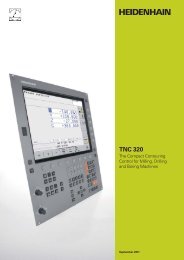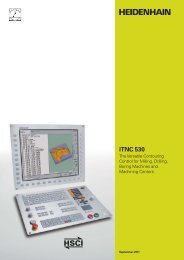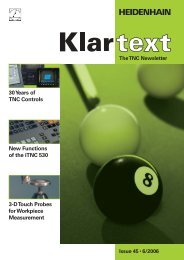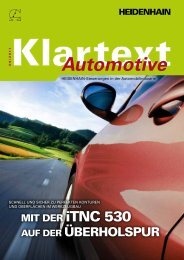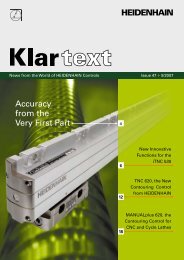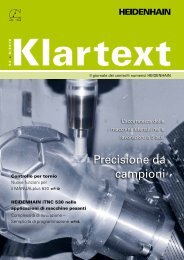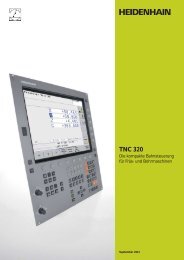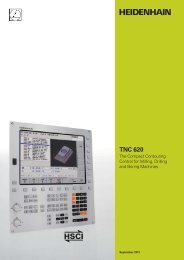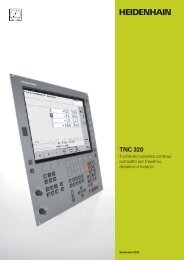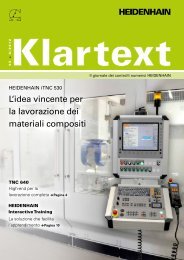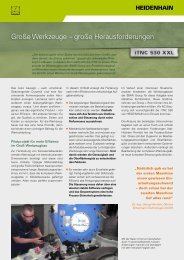34049x-02 - DR. JOHANNES HEIDENHAIN GmbH
34049x-02 - DR. JOHANNES HEIDENHAIN GmbH
34049x-02 - DR. JOHANNES HEIDENHAIN GmbH
Create successful ePaper yourself
Turn your PDF publications into a flip-book with our unique Google optimized e-Paper software.
Important for the Protection of the Machine<br />
– the Dynamic Collision Monitoring Option (DCM)<br />
The complex motions and high traversing<br />
speeds of fi ve-axis machining make axis<br />
movements diffi cult to foresee. This<br />
makes collision monitoring a valuable<br />
function that relieves the machine operator<br />
and protects the machine from damage.<br />
NC programs from CAM systems may<br />
avoid collisions of the tool or tool holder<br />
with the workpiece, but unless you invest<br />
in expensive offl ine machine simulation<br />
software they ignore the machine<br />
components located within the work<br />
envelope. And even then it cannot be<br />
guaranteed that machine conditions, such<br />
as the fi xture position, will be identical to<br />
those of the simulation. In the worst case,<br />
a collision will remain undetected until the<br />
damage is done.<br />
In cases such as these, the machine<br />
operator is supported by the dynamic<br />
collision monitoring feature (DCM) of the<br />
iTNC 530 (only runs on the MC 422B). The<br />
control interrupts machining whenever a<br />
collision threatens and thereby increases<br />
safety for the machine and its operator.<br />
This helps to prevent machine damage,<br />
which can result in costly downtimes.<br />
Unattended shifts become safer and more<br />
reliable.<br />
However, DCM works not only in<br />
automatic mode. It is also active in<br />
manual operation. If, for example, during<br />
setup the machine operator takes a<br />
collision course to a component in the<br />
working space, the iTNC 530 detects it,<br />
stops axis movement, and issues an error<br />
message.<br />
If two machine components come too<br />
close to each other, there are three<br />
warning stages:<br />
Advance warning if below 14 mm<br />
clearance<br />
Warning if below 8 mm clearance<br />
Error if below 8 mm clearance<br />
Of course the iTNC 530 also shows the<br />
machine operator which machine<br />
components are endangered.<br />
The machine operator can acknowledge<br />
advance warnings and warnings and then<br />
continue with normal axis operation. If an<br />
error message appears, DCM must be<br />
switched off. Only then can the danger of<br />
collision be removed and the axes taken<br />
out of danger.<br />
The machine tool builder takes care of the<br />
required defi nition of machine components.<br />
The working space and the<br />
collision objects are described using<br />
geometric bodies such as planes, cubes<br />
and cylinders. Complex machine components<br />
can be modeled with multiple<br />
geometric bodies. The tool is automatically<br />
considered a cylinder of the tool radius<br />
(defi ned in the tool table). For tilting<br />
devices, the machine tool builder can use<br />
the tables for the machine kinematics also<br />
to defi ne the collision objects.<br />
The last step of the confi guration process<br />
is defi ning which machine components<br />
can collide. For example, a tool touch<br />
probe like the <strong>HEIDENHAIN</strong> TT clamped<br />
on the machine table can never come into<br />
contact with the machine cabin. Because<br />
the machine design in itself prevents<br />
collisions between certain machine<br />
components, they can be ruled out from<br />
the start.<br />
Please note when using the dynamic<br />
collision monitoring:<br />
While DCM can help reduce the danger<br />
of collision, it cannot eliminate it.<br />
Only the machine manufacturer can<br />
defi ne collision objects.<br />
Collisions between machine components<br />
(such as swivel heads) and the<br />
workpiece cannot be detected.<br />
Handwheel superimposition (M118) is<br />
not possible.<br />
DCM cannot be used during operation in<br />
following error mode (which means<br />
without feedforward).<br />
It is not possible to monitor for collision<br />
before machining.<br />
3



